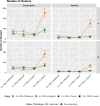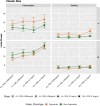This is a preprint.
Unmasking Convergent Oxycodone Seeking and Consumption Driving Augmented Intake during Extended Access to Oral Operant Self-Administration
- PMID: 40463186
- PMCID: PMC12132477
- DOI: 10.1101/2025.05.07.652717
Unmasking Convergent Oxycodone Seeking and Consumption Driving Augmented Intake during Extended Access to Oral Operant Self-Administration
Abstract
Individual vulnerability to opioid intake escalation is a critical but poorly understood aspect of addiction. Using genetically diverse inbred rat strains, we investigated operant oral oxycodone self-administration, identifying 'Augmenter' phenotypes that dramatically increased consumption during extended (16h vs. 4h) access-a vulnerability not predicted by standard motivation tests. A key innovation was applying lick microstructure analysis (LMA) to operationally distinguish 'consumption' from 'seeking' lick clusters within the inter-reward interval. During extended access, Augmenters of both sexes exhibited a striking surge in the frequency of both consumption and seeking clusters (p<0.0001), driving their escalated intake. Notably, female Augmenters also showed larger seeking cluster sizes (p=0.006), suggesting enhanced reward value specifically linked to seeking behavior. In contrast, interlick interval (a palatability measure) did not differentiate phenotypes. This LMA-based approach reveals that an increased drive to seek out additional oxycodone, rather than altered hedonic impact alone, underlies the augmentation of opioid intake, offering a nuanced rodent model of heightened vulnerability and a powerful tool to dissect reward dynamics.
Figures






References
-
- Volkow ND, Wang GJ, Maynard L, Jayne M, Fowler JS, Zhu W, Logan J, Gatley SJ, Ding YS, Wong C, Pappas N. Brain dopamine is associated with eating behaviors in humans. Int J Eat Disord. Wiley; 2003. Mar;33(2):136–142. - PubMed
Publication types
Grants and funding
LinkOut - more resources
Full Text Sources
